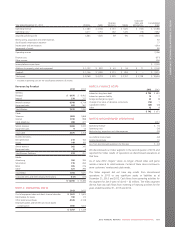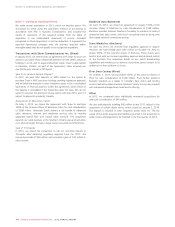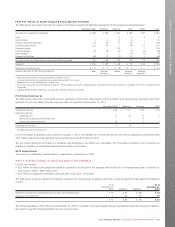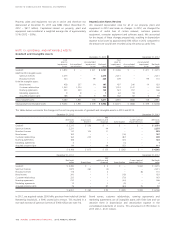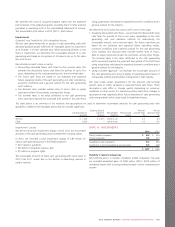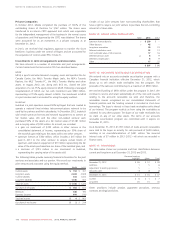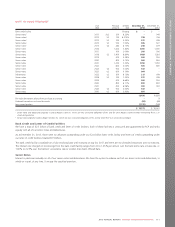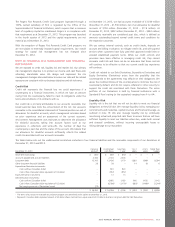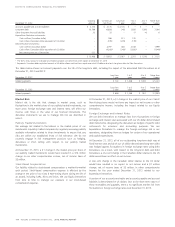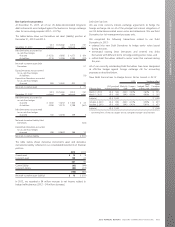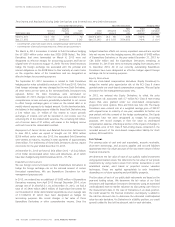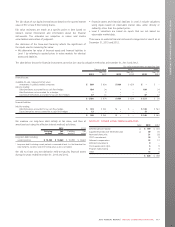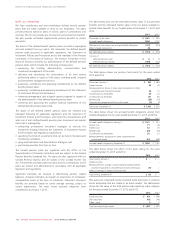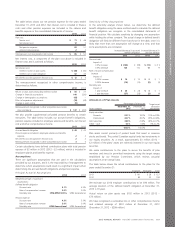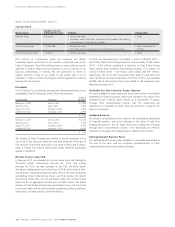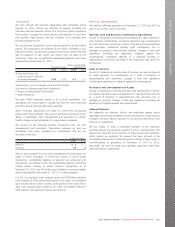Rogers 2013 Annual Report Download - page 117
Download and view the complete annual report
Please find page 117 of the 2013 Rogers annual report below. You can navigate through the pages in the report by either clicking on the pages listed below, or by using the keyword search tool below to find specific information within the annual report.
NOTES TO CONSOLIDATED FINANCIAL STATEMENTS
The Rogers First Rewards Credit Card program (operated through a
100% owned subsidiary of RCI) is regulated by the Office of the
Superintendent of Financial Institutions, which requires that a minimum
level of regulatory capital be maintained. Rogers is in compliance with
that requirement as at December 31, 2013. This program was launched
in the fourth quarter of 2013 and the capital requirements are not
material as at December 31, 2013.
With the exception of Rogers First Rewards Credit Card program, we
are not subject to externally imposed capital requirements. Our overall
strategy for capital risk management has not changed since
December 31, 2012.
NOTE 20: FINANCIAL RISK MANAGEMENT AND FINANCIAL
INSTRUMENTS
We are exposed to credit risk, liquidity risk and market risk. Our primary
risk management objective is to protect our income and cash flows and,
ultimately, shareholder value. We design and implement the risk
management strategies discussed below to ensure our risks and the related
exposures are consistent with our business objectives and risk tolerance.
Credit Risk
Credit risk represents the financial loss we could experience if a
counterparty to a financial instrument, in which we have an amount
owing from the counterparty, failed to meet its obligations under the
terms and conditions of its contracts with us.
Our credit risk is primarily attributable to our accounts receivable. Our
broad customer base limits the concentration of this risk. Our accounts
receivable in the consolidated statements of financial position are net of
allowances for doubtful accounts, which management estimates based
on prior experience and an assessment of the current economic
environment. Management uses estimates to determine the allowance
for doubtful accounts, taking into account factors such as our
experience in collections and write-offs, the number of days the
counterparty is past due and the status of the account. We believe that
our allowance for doubtful accounts sufficiently reflects the related
credit risk associated with our accounts receivable.
At December 31, 2013, we had accounts receivable of $1,509 million
(December 31, 2012 – $1,536 million), net of an allowance for doubtful
accounts of $104 million (December 31, 2012 – $119 million). At
December 31, 2013, $452 million (December 31, 2012 – $492 million)
of accounts receivable are considered past due, which is defined as
amounts outstanding beyond normal credit terms and conditions for
the respective customers.
We use various internal controls, such as credit checks, deposits on
account and billing in advance, to mitigate credit risk, and will suspend
services when customers have fully used their approved credit limits or
violated established payment terms. While our credit controls and
processes have been effective in managing credit risk, they cannot
eliminate credit risk and there can be no assurance that these controls
will continue to be effective or that our current credit loss experience
will continue.
Credit risk related to our Debt Derivatives, Expenditure Derivatives and
Equity Derivatives (Derivatives) arises from the possibility that the
counterparties to the agreements may default on their obligations. We
assess the creditworthiness of the counterparties to minimize the risk of
counterparty default, and do not require collateral or other security to
support the credit risk associated with these Derivatives. The entire
portfolio of our Derivatives is held by financial institutions with a
Standard & Poor’s rating (or the equivalent) ranging from A- to AA-.
Liquidity Risk
Liquidity risk is the risk that we will not be able to meet our financial
obligations as they fall due. We manage liquidity risk by managing our
commitments and maturities, capital structure and financial leverage, as
outlined in note 19. We also manage liquidity risk by continually
monitoring actual and projected cash flows to ensure that we will have
sufficient liquidity to meet our liabilities when due, under both normal
and stressed conditions, without incurring unacceptable losses or
risking damage to our reputation.
The tables below sets out the undiscounted contractual maturities of our financial liabilities and the receivable components of our derivatives at
December 31, 2013 and 2012.
December 31, 2013
Carrying
amount
Contractual
cash flows
Less than
1 year
1to3
years
4to5
years
More than
5 years
Short-term borrowings $ 6501$ 6501$ 6501$–$–$ –
Accounts payable and accrued liabilities 2,344 2,344 2,344 – – –
Long-term debt 13,343 13,436 1,170 1,883 1,989 8,394
Other long-term financial liabilities 38 38 – 14 18 6
Expenditure Derivative instruments:
Cash outflow (Canadian dollar) – 923 923 – – –
Cash inflow (Canadian dollar equivalent of US dollar) – (957) (957) – – –
Equity Derivative instruments – 13 13 – – –
Debt Derivative instruments:
Cash outflow (Canadian dollar) – 6,665 1,183 905 1,435 3,142
Cash inflow (Canadian dollar equivalent of US dollar) – (6,786)2(1,170)2(883)2(1,489)2(3,244)2
Net carrying amount of Derivatives (asset) (75)
$ 16,300 $ 16,326 $ 4,156 $ 1,919 $ 1,953 $ 8,298
1The terms of our accounts receivable securitization program are committed until it expires on December 31, 2015.
2Represents Canadian dollar equivalent amount of US dollar inflows matched to an equal amount of US dollar maturities in long-term debt for Debt Derivatives.
2013 ANNUAL REPORT ROGERS COMMUNICATIONS INC. 113


